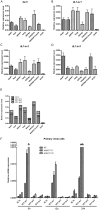Diverse interleukin-7 mRNA transcripts in Chinese tree shrew (Tupaia belangeri chinensis)
- PMID: 24945249
- PMCID: PMC4063794
- DOI: 10.1371/journal.pone.0099859
Diverse interleukin-7 mRNA transcripts in Chinese tree shrew (Tupaia belangeri chinensis)
Abstract
Interleukin-7 (IL7) is a pleiotropic cytokine that is actively involved in the immune system. The Chinese tree shrew (Tupaia belangeri chinensis) has been proposed as an alternative experimental animal to primates in biomedical research. However, there is a lack of biological knowledge about the immune system of the tree shrew. In this study, we cloned the IL7 gene (tIL7) in the Chinese tree shrew and quantified the expression of mRNA transcripts in eight tissues (heart, liver, spleen, lung, kidney, intestine, skeletal muscle and brain) from 20 individuals. Eleven tIL7 mRNA transcripts were identified in different tissues. The canonical form (tIL7c) had a length of 1817 bp and encoded a predicted gene product with 177 amino acids. Phylogenetic analyses based on the amino acid sequences revealed a considerably large genetic difference between tree shrew and human. Quantification of mRNA expression of transcripts tIL7c, tIL7-sv1, tIL7-sv2 and tIL7-sv3 showed that these transcripts were expressed in all tissues, albeit the expression levels varied in different tissues. Transcripts tIL7c, tIL7-sv1, and tIL7-sv2 had the lowest expression in brain, and tIL7-sv3 had a dramatically high mRNA expression in skeletal muscle and heart. The mRNA expression levels of tIL7c and tIL7-sv1 were significantly increased upon ploy(I:C) stimulation in tree shrew primary renal cells. As with human full-length IL7, tIL7c, tIL7-sv1, tIL7-sv2 and tIL7-sv3 showed similar a subcellular localization pattern. Our results identified diverse tIL7 transcripts in the Chinese tree shrew, which may play a potential role in modulating IL7-regulated biological effects.
Conflict of interest statement
Figures






Similar articles
-
Molecular characterization of the 2',5'-oligoadenylate synthetase family in the Chinese tree shrew (Tupaia belangeri chinensis).Cytokine. 2019 Feb;114:106-114. doi: 10.1016/j.cyto.2018.11.009. Epub 2018 Nov 20. Cytokine. 2019. PMID: 30467096
-
Molecular identification and antiviral function of the guanylate-binding protein (GBP) genes in the Chinese tree shrew (Tupaia belangeri chinesis).Dev Comp Immunol. 2019 Jul;96:27-36. doi: 10.1016/j.dci.2019.02.014. Epub 2019 Feb 25. Dev Comp Immunol. 2019. PMID: 30817937
-
Identification of SEC14 like lipid binding 2(SEC14L2) sequence and expression profiles in the Chinese tree shrew (Tupaia belangeri chinensis).Mol Biol Rep. 2022 Aug;49(8):7307-7314. doi: 10.1007/s11033-022-07518-7. Epub 2022 Jun 29. Mol Biol Rep. 2022. PMID: 35767108
-
Tree shrew (Tupaia belangeri) as a novel laboratory disease animal model.Zool Res. 2017 May 18;38(3):127-137. doi: 10.24272/j.issn.2095-8137.2017.033. Zool Res. 2017. PMID: 28585436 Free PMC article. Review.
-
Study of tree shrew biology and models: A booming and prosperous field for biomedical research.Zool Res. 2024 Jul 18;45(4):877-909. doi: 10.24272/j.issn.2095-8137.2024.199. Zool Res. 2024. PMID: 39004865 Free PMC article. Review.
Cited by
-
The Tree Shrew as a Model for Cancer Research.Front Oncol. 2021 Mar 9;11:653236. doi: 10.3389/fonc.2021.653236. eCollection 2021. Front Oncol. 2021. PMID: 33768009 Free PMC article. Review.
-
A study of Epstein-Barr virus infection in the Chinese tree shrew(Tupaia belangeri chinensis).Virol J. 2017 Oct 6;14(1):193. doi: 10.1186/s12985-017-0859-5. Virol J. 2017. PMID: 28985762 Free PMC article.
-
Characterization of tree shrew (Tupaia belangeri) interleukin-6 and its expression pattern in response to exogenous challenge.Int J Mol Med. 2017 Dec;40(6):1679-1690. doi: 10.3892/ijmm.2017.3168. Epub 2017 Oct 2. Int J Mol Med. 2017. PMID: 29039460 Free PMC article.
-
Identification and characterization of the tumor necrosis factor receptor superfamily in the Chinese tree shrew (Tupaia belangeri chinensis).BMC Genomics. 2025 Apr 4;26(1):338. doi: 10.1186/s12864-025-11451-x. BMC Genomics. 2025. PMID: 40186114 Free PMC article.
-
Construction of complete Tupaia belangeri transcriptome database by whole-genome and comprehensive RNA sequencing.Sci Rep. 2019 Aug 26;9(1):12372. doi: 10.1038/s41598-019-48867-x. Sci Rep. 2019. PMID: 31451757 Free PMC article.
References
Publication types
MeSH terms
Substances
LinkOut - more resources
Full Text Sources
Other Literature Sources
Research Materials

